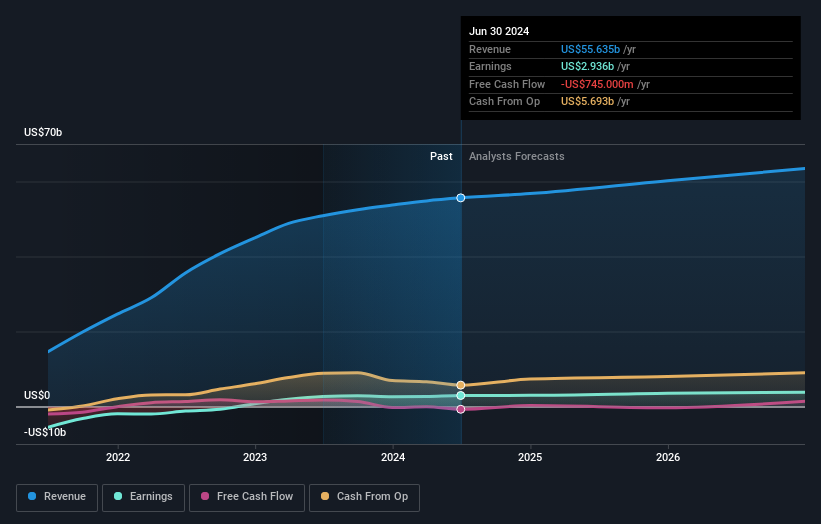- United States
- /
- Airlines
- /
- NasdaqGS:UAL
United Airlines Holdings, Inc. (NASDAQ:UAL) Just Reported Second-Quarter Earnings: Have Analysts Changed Their Mind On The Stock?

Investors in United Airlines Holdings, Inc. (NASDAQ:UAL) had a good week, as its shares rose 3.7% to close at US$46.39 following the release of its second-quarter results. United Airlines Holdings reported in line with analyst predictions, delivering revenues of US$15b and statutory earnings per share of US$3.96, suggesting the business is executing well and in line with its plan. The analysts typically update their forecasts at each earnings report, and we can judge from their estimates whether their view of the company has changed or if there are any new concerns to be aware of. We thought readers would find it interesting to see the analysts latest (statutory) post-earnings forecasts for next year.
See our latest analysis for United Airlines Holdings

Taking into account the latest results, the current consensus from United Airlines Holdings' 18 analysts is for revenues of US$56.8b in 2024. This would reflect a satisfactory 2.0% increase on its revenue over the past 12 months. Statutory per share are forecast to be US$9.03, approximately in line with the last 12 months. Yet prior to the latest earnings, the analysts had been anticipated revenues of US$57.1b and earnings per share (EPS) of US$9.84 in 2024. So it looks like there's been a small decline in overall sentiment after the recent results - there's been no major change to revenue estimates, but the analysts did make a small dip in their earnings per share forecasts.
The consensus price target held steady at US$69.21, with the analysts seemingly voting that their lower forecast earnings are not expected to lead to a lower stock price in the foreseeable future. Fixating on a single price target can be unwise though, since the consensus target is effectively the average of analyst price targets. As a result, some investors like to look at the range of estimates to see if there are any diverging opinions on the company's valuation. Currently, the most bullish analyst values United Airlines Holdings at US$98.00 per share, while the most bearish prices it at US$36.00. Note the wide gap in analyst price targets? This implies to us that there is a fairly broad range of possible scenarios for the underlying business.
One way to get more context on these forecasts is to look at how they compare to both past performance, and how other companies in the same industry are performing. It's pretty clear that there is an expectation that United Airlines Holdings' revenue growth will slow down substantially, with revenues to the end of 2024 expected to display 4.1% growth on an annualised basis. This is compared to a historical growth rate of 13% over the past five years. Compare this against other companies (with analyst forecasts) in the industry, which are in aggregate expected to see revenue growth of 7.8% annually. Factoring in the forecast slowdown in growth, it seems obvious that United Airlines Holdings is also expected to grow slower than other industry participants.
The Bottom Line
The most important thing to take away is that the analysts downgraded their earnings per share estimates, showing that there has been a clear decline in sentiment following these results. Fortunately, the analysts also reconfirmed their revenue estimates, suggesting that it's tracking in line with expectations. Although our data does suggest that United Airlines Holdings' revenue is expected to perform worse than the wider industry. There was no real change to the consensus price target, suggesting that the intrinsic value of the business has not undergone any major changes with the latest estimates.
With that said, the long-term trajectory of the company's earnings is a lot more important than next year. We have forecasts for United Airlines Holdings going out to 2026, and you can see them free on our platform here.
Plus, you should also learn about the 1 warning sign we've spotted with United Airlines Holdings .
If you're looking to trade United Airlines Holdings, open an account with the lowest-cost platform trusted by professionals, Interactive Brokers.
With clients in over 200 countries and territories, and access to 160 markets, IBKR lets you trade stocks, options, futures, forex, bonds and funds from a single integrated account.
Enjoy no hidden fees, no account minimums, and FX conversion rates as low as 0.03%, far better than what most brokers offer.
Sponsored ContentNew: AI Stock Screener & Alerts
Our new AI Stock Screener scans the market every day to uncover opportunities.
• Dividend Powerhouses (3%+ Yield)
• Undervalued Small Caps with Insider Buying
• High growth Tech and AI Companies
Or build your own from over 50 metrics.
Have feedback on this article? Concerned about the content? Get in touch with us directly. Alternatively, email editorial-team (at) simplywallst.com.
This article by Simply Wall St is general in nature. We provide commentary based on historical data and analyst forecasts only using an unbiased methodology and our articles are not intended to be financial advice. It does not constitute a recommendation to buy or sell any stock, and does not take account of your objectives, or your financial situation. We aim to bring you long-term focused analysis driven by fundamental data. Note that our analysis may not factor in the latest price-sensitive company announcements or qualitative material. Simply Wall St has no position in any stocks mentioned.
Have feedback on this article? Concerned about the content? Get in touch with us directly. Alternatively, email editorial-team@simplywallst.com
About NasdaqGS:UAL
United Airlines Holdings
Through its subsidiaries, provides air transportation services in North America, Asia, Europe, Africa, the Pacific, the Middle East, and Latin America.
Good value with proven track record.


